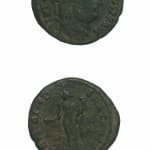Bronze Follis of Emperor Galerius, 305 CE - 311 CE
Bronze
C.4725
Obverse: IMP C GAL VAL MAXIMIANVS PF AVG; Laureate Bust of the Emperor Facing Righ Reverse: GENIO IMPERATORIS; Genius Standing to the Left, Pouring Libations from a Patera and Holding...
Obverse: IMP C GAL VAL MAXIMIANVS PF AVG; Laureate Bust of the Emperor Facing Righ
Reverse: GENIO IMPERATORIS; Genius Standing to the Left, Pouring Libations from a Patera and Holding a Cornucopi
The Third Century A.D. was a chaotic era for the Roman Empire, characterized by constant infighting and familial rivalries for the throne. To bring order to this chaos, Emperor Diocletian created the Tetrarchy, whereby four emperors, two Augusti and two Caesars, ruled the empire. Emperor Galerius served as Caesar under Diocletian, ruling the Danube frontier from 293 until 305 when Diocletian abdicated and Galerius became Augustus of the East. Constantius I ruled as Augustus of the West. The two chose Maximinus II and Severus II to rule beneath them. However, without Diocletian's resolve to keep them in line, the four men began to compete with each other for power. Things came to a head in A. D. 306. Constantius I died while campaigning in Britain. The British legions immediately proclaimed his son Constantine emperor. With threats of a rebellion that might destroy all of Diocletian's reformations, Galerius decided to recognize Constantine rather than risk civil war. Later that year, the citizens of Rome rebelled after Galerius decreed that they would have to pay taxes for the first time since Republican days, declaring Maxentius Emperor. To prevent a return to the anarchy that characterized the Third Century, Galerius called a peace conference at Carnuntum on the Danube frontier presided over by Diocletian. Constantine was demoted to the rank of Caesar, and Maxentius was declared an outlaw. In May of 311 A. D., Galerius died of what most sources describe as a “dreadful disease," recognizing the Christian God shortly before he passed.
How many hands have touched a coin in your pocket or purse? What eras and lands have the coin traversed on its journey into our possession? As we reach into our pockets to pull out some change, we rarely hesitate to think of who might have touched the coin before us, or where the coin will venture to after it leaves our hands. More than money, coins are a symbol of the state that struck them, of a specific time and location, whether contemporary currencies or artifacts of a long forgotten empire. This stunning hand-struck coin reveals an expertise of craftsmanship and intricate sculptural detail that is often lacking in contemporary machine-made currencies. This ancient coin is a memorial to Galerius, passed from the hands of civilization to civilization, from generation to generation that still appears as vibrant today as the day it was struck.
Reverse: GENIO IMPERATORIS; Genius Standing to the Left, Pouring Libations from a Patera and Holding a Cornucopi
The Third Century A.D. was a chaotic era for the Roman Empire, characterized by constant infighting and familial rivalries for the throne. To bring order to this chaos, Emperor Diocletian created the Tetrarchy, whereby four emperors, two Augusti and two Caesars, ruled the empire. Emperor Galerius served as Caesar under Diocletian, ruling the Danube frontier from 293 until 305 when Diocletian abdicated and Galerius became Augustus of the East. Constantius I ruled as Augustus of the West. The two chose Maximinus II and Severus II to rule beneath them. However, without Diocletian's resolve to keep them in line, the four men began to compete with each other for power. Things came to a head in A. D. 306. Constantius I died while campaigning in Britain. The British legions immediately proclaimed his son Constantine emperor. With threats of a rebellion that might destroy all of Diocletian's reformations, Galerius decided to recognize Constantine rather than risk civil war. Later that year, the citizens of Rome rebelled after Galerius decreed that they would have to pay taxes for the first time since Republican days, declaring Maxentius Emperor. To prevent a return to the anarchy that characterized the Third Century, Galerius called a peace conference at Carnuntum on the Danube frontier presided over by Diocletian. Constantine was demoted to the rank of Caesar, and Maxentius was declared an outlaw. In May of 311 A. D., Galerius died of what most sources describe as a “dreadful disease," recognizing the Christian God shortly before he passed.
How many hands have touched a coin in your pocket or purse? What eras and lands have the coin traversed on its journey into our possession? As we reach into our pockets to pull out some change, we rarely hesitate to think of who might have touched the coin before us, or where the coin will venture to after it leaves our hands. More than money, coins are a symbol of the state that struck them, of a specific time and location, whether contemporary currencies or artifacts of a long forgotten empire. This stunning hand-struck coin reveals an expertise of craftsmanship and intricate sculptural detail that is often lacking in contemporary machine-made currencies. This ancient coin is a memorial to Galerius, passed from the hands of civilization to civilization, from generation to generation that still appears as vibrant today as the day it was struck.
1
of
18



